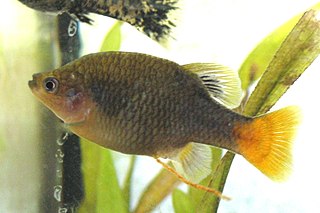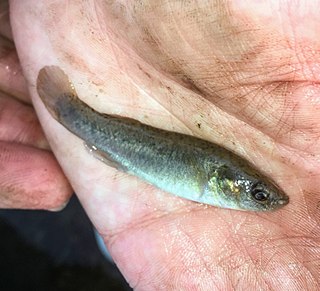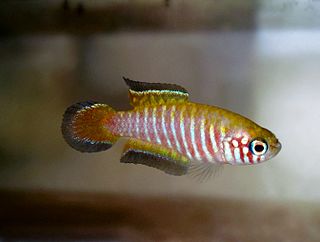
Goodeidae is a family of teleost fish endemic to Mexico and some areas of the United States. Many species are known as splitfins. This family contains about 50 species within 18 genera. The family is named after ichthyologist George Brown Goode (1851-1896).

The Ash Meadows killifish is a species of killifish from the subfamily Empetrichthyinae, part of the family Goodeidae, which was first documented by C. H. Gilbert in 1893 and historically occupied numerous springs near Ash Meadows, Nye County, Nevada, United States. This species was last seen in 1948 and is believed to have gone extinct in the early 1950s, likely as a result of habitat alteration and competition with and predation by introduced crayfish Procambarus clarkii, mosquitofish, black mollies, and bullfrogs.
Campellolebias is a genus of killifish in the family Rivulidae from southeast Brazil. They are restricted to seasonal blackwater pools in forests in coastal parts of Santa Catarina and São Paulo states.

The saltmarsh topminnow is a species of killifish for the family Fundulidae. It occurs in the costal wetlands of the Gulf of Mexico in the United States.

Goodeinae is a subfamily of splitfins from Mexico, part of the family Goodeidae. They are small fish which mostly live in fresh water, especially around Mesa Central, west of Mexico City. Members of the subfamily are also found in brackish water on both the east and west coasts. They typically have small ranges and many are seriously threatened. The subfamily takes its named from its type genus Goodea and so is ultimately named after the American ichthyologist George Brown Goode (1851-1896).

Profundulus is a genus of fish in the family Profundulidae endemic to Mexico and northern Central America. According to many authorities, including Fishbase this is the only genus in the Profundulidae but workers have split the genus and raised a second genus Tlaloc.

Cubanichthys is a small genus of pupfishes endemic to the Caribbean Islands of Cuba and Jamaica. The name of this genus is a compound of Cuba, where the genus was thought to be endemic until C. pengellyi was placed in the genus, and the Greek word for "fish, ichthys.

Profundulidae is a family of killifishes. The species of this family are native to Central America and Mexico.
The Mexican rivulus is a species of killifish from the family Rivulidae which is endemic to Mexico where it is found in the Papaloapan and Coatzacoalcos River basins. This annual killifish grows to a total length of 4 cm (1.6 in). It is the only known species in its genus, but its exact taxonomic position remains uncertain, as it has not been included in any phylogenetic study. This species was described by Robert Rush Miller and Carl Leavitt Hubbs as Rivulus robustus in 1974, it was reclassified in the monotypic genus Millerichthys in 1995, the generic name honouring Robert Rush Miller.
Rachovia is a genus of killifish from the family Rivulidae the species of which are endemic to the Orinoco, Maracaibo and Magdalena basins in Colombia and Venezuela, where they live in small temporary waters like ponds. They are small annual killifish that reach up to 6 cm (2.4 in) in total length. The name of this genus honours the German aquarist Arthur Rachow (1884-1960) who sent fish specimens to George S. Myers.
Renova oscari is a species of killifish from the family Rivulidae which is endemic to the Orinoco River basin of Venezuela. This annual killifish grows to a standard length of 4.7 cm (1.9 in). This species is the only known member of its genus. It is found in the aquarium trade. This species was described in 1995 by Jamie E. Thomerson and Donald Charles Taphorn Baechle with the type locality given as the southwestern edge of Isla Raton in the vicinity of the village of Sabanita, upper Río Orinoco. The specific name honours Oscar León Mata (1964-2018), a killifish collector, environmental engineer and curator of fish at Museo de Ciencias Naturales in Guanare.

Simpsonichthys is a genus of killifish from the family Rivulidae the species of which are endemic to temporary freshwater habitats like ponds in the upper Paraná, upper Araguaia, upper Jequitinhonha and São Francisco basins on the central Brazilian Plateau. They are small annual killifish that reach up to 5.5 cm (2.2 in) in standard length.

Mucurilebias leitaoi is a species of rivulid killifish endemic to Brazil where it occurs, or formerly occurred, in the basin of the Mucuri River. This species can reach a length of 3 centimetres (1.2 in) TL. This species has not been seen since the original series of types was collected in 1988 and it may have become extinct due to the extensive habitat loss in the region. This species is the only known member of its genus, but it was formerly included in Leptolebias. The specific name of this fish honours the Brazilian ichthyologist and herpetologist Antenor Leitão de Carvalho (1910-1985).
The Dead Sea toothcarp is a subspecies of the Arabian toothcarp that is endemic to the Dead Sea basin, although molecular evidence suggests that it should be regarded as a species. It is threatened by water fluctuation, and the introduction of cichlids and Gambusia. The sub-specific name of this fish honours the Scottish surgeon and naturalist John Richardson (naturalist) (1787-1865) who first reported killifish in the Dead Sea basin.

Simpsonichthys constanciae is a species of killifish from the family Rivulidae that is endemic to Brazil. It is restricted to temporary freshwater habitats in the São João basin in Rio de Janeiro, while all other species in the genus are from Bahia. It is a small killifish that is up to 6 cm (2.4 in) in total length. The specific name of this fish honours Constance White, an American watercolour painter, who collected type of this fish with her husband, Lieutenant colonel Thomas D. White, and created colour sketches for George S. Myers.

The Seminole killifish is a fish of the genus Fundulus, endemic to the U.S. state of Florida.

Goodea luitpoldii, the green goodea, is species of killifish from the family Goodeidae which is endemic to the drainage basin of the Lerma River and the Grande de Santiago River in Mexico. This species was Species description described as Characodon luitpoldii by the Franz Steindachner in 1894 with the type localisty given as Lake Pátzcuaro in Michoacán. The identity of the person homnoured in its specific name is unknown but it is thought likely to be Luitpold, Prince Regent of Bavaria (1821-1912) whose daughter, Princess Therese of Bavaria (1850-1925) was an explorer and amateur naturalist and she collected the type.
Valencia robertae is a species of Mediterranean killifish, from the family Valenciidae. It is endemic to Greece where it is found in the Lower Pinios and lower Mornos Rivers in Greece. The species was described in 2004 with the type locality given as River Pinios south of Kavasila> The specific name honours the Italian ichthyologist Roberta Barbieri of the Hellenic Centre for Marine Research in Athens.
Cubanichthys pengelleyi, the Jamaican killifish, is a species of killifish from the family Cyprinodontidae, the pupfishes, which is endemic to Jamaica. It is found in shallow, crystal clear waters with a depth of 1.5 metres (4.9 ft) and a pH of 8.2). These have s substrate consisting mainly of sand with some softer patches of silt. This species hides among saquatic vegetation. Its prey consists of damselfly and dragonfly larvae, the larvae of other aquatic insects, ostracods, copepods and snails. The specific name honours the Jamiacan physician and medical officer Charles Edward Pengelley (1888-1966) who obtained the type.














